Special effects in movies: 10 stunning examples
Discover the best visual effects that elevated cinema.
Most people have their favourite examples of special effects in movies. Creating the best visual effects is an integral and exciting part of film making, and every so often a movie comes out that's a VFX game-changer.
We asked the readers of Creative Bloq and 3D World which VFX films had most impressed them, or defined or changed the industry, and their top 10 movies are listed below, in descending order.
Whether your favourite is one of the best 3d movies, a film with incredible explosions or character design, or even one containing invisible VFX that most viewers won't notice – there will be something for you in this list.
The criteria to be included in the top 10 was simple: the movie must have a running time of 60 minutes or longer; have received a full cinematic release; and have a significant or innovative element of CG VFX work. We've intentionally omitted CG animations and only included films that blend CG and live action. Has your favourite VFX film made the final cut?
10. Dawn of the Planet of the Apes
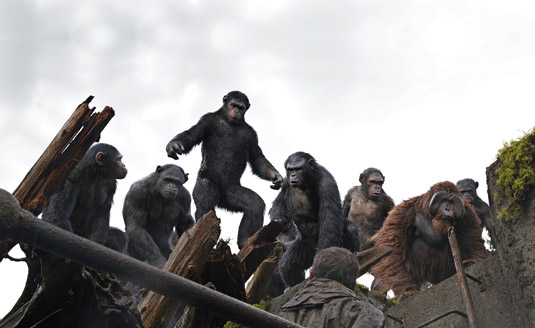
Building on the success of 2011's Rise of the Planet of the Apes, this tale of humans and super-intelligent apes battling for survival in a post-apocalyptic near-future is a technological masterpiece. Weta Digital's CG creatures are very much the stars of the show, and have minutes of screen time with no human interaction. It feels unfair to single out individual scenes, as the effects are incredible throughout.
But it's the intimate moments that really stand out. Those shots in which human actors react to computer-generated apes carry genuine emotional depth. For once, CG characters are not simply there to advance the action but to perform: to carry a narrative arc.
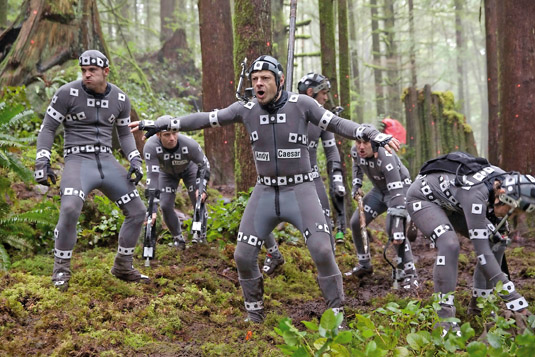
The digital apes – 12 hero characters, plus around 20 'extras' – were created using a mixture of hand animation and motion-capture footage of Andy Serkis and the other actors portraying the creatures.
Get the Creative Bloq Newsletter
Daily design news, reviews, how-tos and more, as picked by the editors.
Much of the mocap was shot on location, which meant an overhaul of the technology. This kit needed to be hauled up mountains, rained on, and generally abused, as Weta Digital sought to capture the most authentic performances possible.
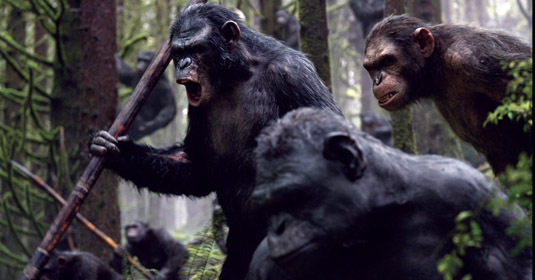
When the gloves did come off and the apes fought, it created new problems – artistically, the actors had to discover how intelligent apes would fight (no biting!), while director Matt Reeves had to get a grip on new workflows, filming the actors in a virtual space and setting beats and camera angles afterward, using virtual cameras.
The hard work resulted in three VES Awards, plus an Oscar nomination for Best Visual Effects. Maybe by the time of the third movie in the series, Hollywood will have accepted motion-captured performances enough to nominate Andy Serkis for Best Actor.
09. Pacific Rim
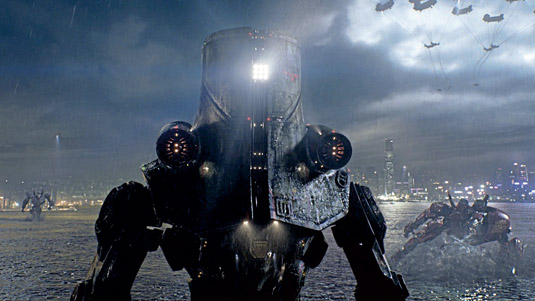
Director Guillermo del Toro's epic blockbuster tells the tale of badass robots saving humankind from monstrous sea creatures. For the work, del Toro assembled a 'dream team' of concept designers, including veteran sci-fi artist Wayne Barlowe, also commissioning maquettes of all the major Kaiju (the sea monsters) and Jaeger (the humanoid war machines) from practical effects firm Spectral Motion.
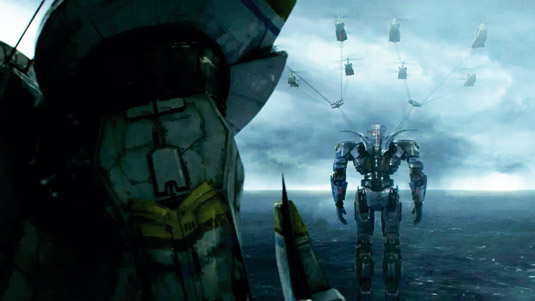
Industrial Light & Magic led the CG work, along with supporting facilities including Ghost FX, Hybride, Rodeo FX and Base FX.
"We put a lot of time into the [Jaegers] Gipsy Danger and Striker Eureka, because they have the most screen time and the most actions," says ILM animation supervisor Hal Hickel. "We focused on how the shoulders and hips would work and how all the mechanisms would fit together. Along the way we'd adjust proportions and other things [based on] Guillermo's input, and we'd then start to move them and see what they looked like in various poses. We focused on how all the mechanisms would fit together.
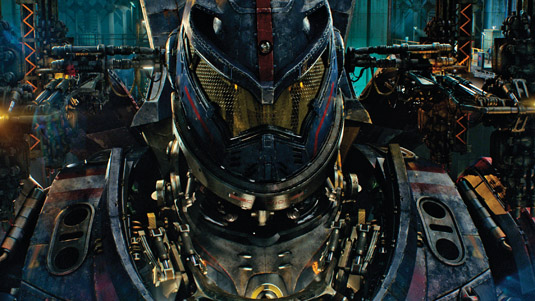
"Once we'd built them in the computer, we were able to start animating them and figuring out things like whether arms needed to be longer or see if the legs looked a little stumpy on a given lens and from a certain angle. There were tons of decisions like this."
In total, ILM spent months working on Gipsy Danger. "We put a lot of detail into the model, but carefully planned where it was needed and when," says Hickel. "We'd look ahead at a sequence and would dress the amount of detail accordingly."
They spent their time wisely – the Pacific Rim creatures instantly joined the canon of beloved movie monsters that audiences love to hate and fear in equal measure, while the visual effects landed six VES Award nominations, one of them for Hickel himself.
08. Gravity
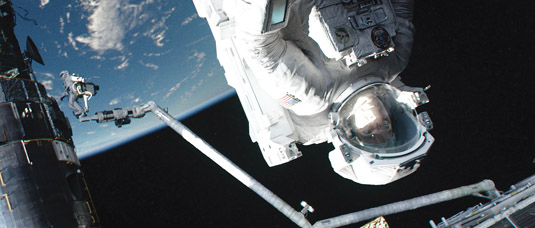
Some films are bogged down with effects; others are light fare. But Alfonso Cuarón's Gravity, set in the weightlessness of space, is a rare union of ethereal CG work and a heavyweight emotional storyline.
Anchored by Sandra Bullock's central performance – or facial performance, at least: for much of the movie, her spacesuit-clad body is animated digitally – as stranded astronaut Dr. Ryan Stone, Framestore's artists created an entire digital world.
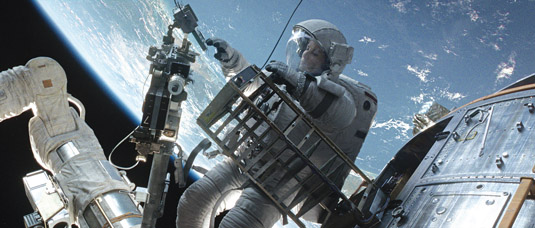
"Gravity is a hybrid: it's partly live-action, but is similar to [an animated feature] in many respects," says animation supervisor Max Solomon. "Very large parts of it are fully CG."
Those 'parts' include the space shuttles, the Hubble Telescope, the International Space Station, and the Earth itself. All are on screen for long periods of time: the opening tracking shot alone lasts 13 minutes.
At the start of the pitch process, it wasn't clear just how much of Gravity would have to be computer-generated. Although early tests were done using more traditional methods such as shooting actors on wire rigs and building physical sets, it soon became clear that the challenges of simulating weightlessness and characters spinning off into the darkness could not be overcome practically. As in so many previous cases, digital effects became the silent star of the film.
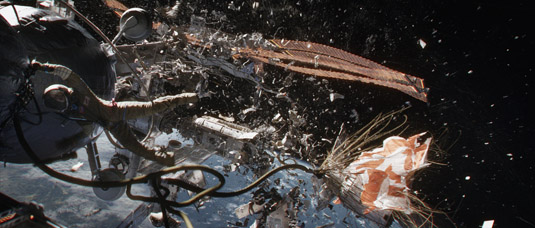
Very few directors are good as Cuarón at making visual effects feel like an organic part of the action. "I think that is what is special about Gravity," says Solomon. "As a space film, it doesn't feel like a VFX film: it feels more like a documentary. That was always something Alfonso stipulated from the beginning, that we were a fly-on-the-wall camera crew following these astronauts through their ordeal."
And that's what's so seductive about Gravity: it makes space seem exciting and scary, but also tricks you into thinking that it's real.
07. Avengers: Age of Ultron
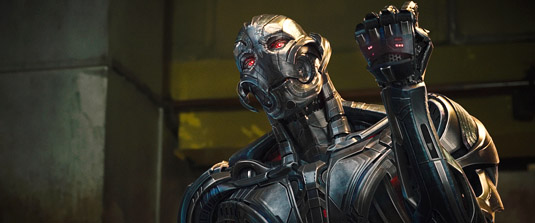
The sequel to 2012 hit Avengers Assemble, Age of Ultron was Marvel Studios' biggest cinematic thrill ride to date. Joss Whedon returned to write and direct, along with visual effects supervisor Chris Townsend, who managed over 10 studios for the last Avengers film and approximately 20 studios this time around.
Industrial Light & Magic handled 800 of the VFX shots, including the opening and closing battles, and the three main CG characters – Hulk, Iron Man in all his forms, and new anti-hero Ultron – dividing the work between teams in San Francisco, Singapore, Vancouver and London.
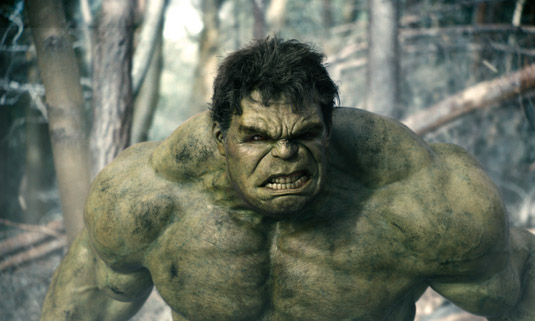
As in the previous movie, Hulk is a highlight of the visual effects. With the digital character appearing in 50 per cent more shots than in the previous film, the studio took a new approach to the green giant’s muscles and flesh. Typically, ILM's artists model the final form for a character's body, then put muscles inside and skin simulations on top. For Ultron, character TDs Sean Comer and Abs Jahromi worked with a professor of medicine to devise a new multi-layer muscle system.

"We built the rig, put the muscle system on top, and the skin on top of that," explains animation director Marc Chu. "So when we animated Hulk, the rig would reverse engineer what the muscles were doing and realistically drive the flesh simulation. In the previous film, we had to do corrections to keep Hulk on model, but the new system [did that semi-automatically]. We could still correct anything that penetrated, and adjust the jiggle to taste, but it made us six times more efficient."
With the movie's other key effects expanding on those of its predecessor in similar ways, the result is a spectacle of superheroic proportions, each scene delivering a range of new visual treats.
06. The Matrix
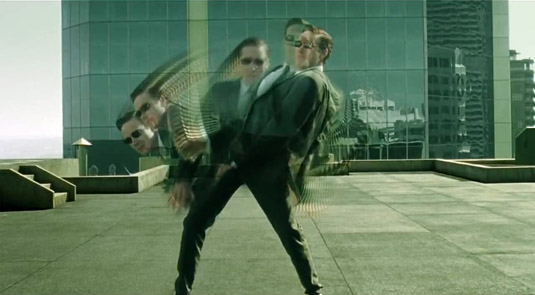
Released in spring 1999, The Matrix was the surprise science fiction hit that beat The Phantom Menace to the finish line in the race for the Academy Award for Visual Effects. It launched the career of first-time visual effects supervisor John Gaeta, then just 34, and goes down in history as the film that raised the bar for the choreography of fight sequences and reinvented cinematography.
Its most iconic scene is a frozen moment that has become known as 'bullet time', in which Neo (Keanu Reeves) dodges bullets fired at him by an agent, while the camera circles around. The sequence still captivates today.
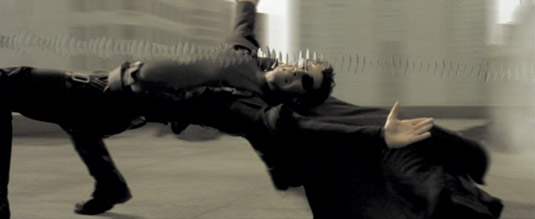
Gaeta's team trained a circular array of 122 still cameras on Keanu Reeves, then triggered them in sequence. Because cameras located on one side of Reeves were visible to those on the other, Gaeta needed a way of generating photorealistic sets so the camera could be removed from frame.
Gaeta and Manex VFX supervisor Kim Libreri found the answer at Siggraph 1997 in 'The Campanile Movie', a short film by Paul Debevec, George Borshukov and Yizhou Yu. Photographs of buildings were reprojected onto their CG models using new, best-fit algorithms. The result was the birth of virtual cinematography.
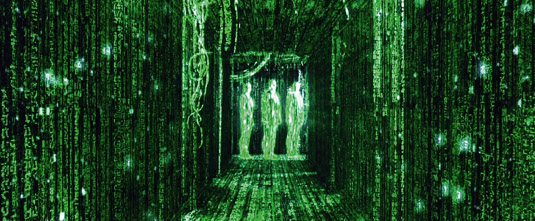
"All my friends who worked on the film were enablers who allowed us to take risks," remembers Gaeta. "That was very important to me at that time, and gave me confidence in everything else I've done since. The Wachowskis give their designers quite a bit of creative freedom, and they really engaged, encouraged and inspired."
Reflecting on the film in 2007, Gaeta noted that there were many shots he'd still like to tweak. "There are a lot of shots that, in the light of what you can do today, are pretty crude. But they still represent ideas the filmmakers were trying to represent." To judge from The Matrix's placement in the poll, they're ideas that endure to this day.
05. Interstellar
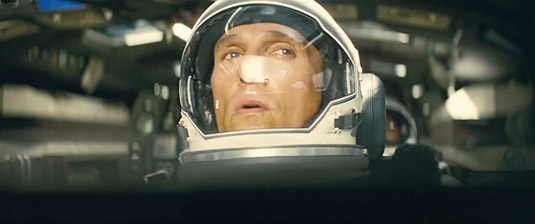
Collaborating once more with director Christopher Nolan, Interstellar challenged Double Negative to visualise the un-visualisable: realistic alien worlds, a mathematically accurate black hole, and the Tesseract, a four-dimensional space with time as a physical dimension. Theoretical physicist Kip Thorne provided the maths, the studio's artists delivered the visuals, and Hollywood awarded them an Oscar.
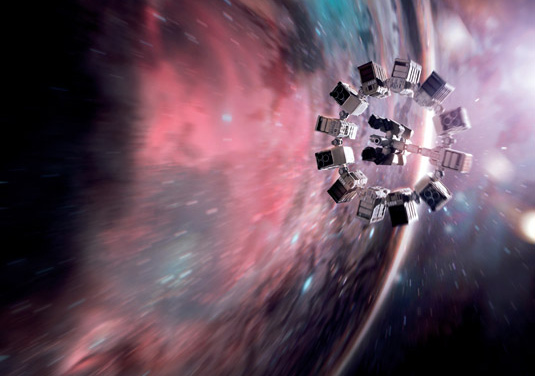
For many viewers, the most memorable shot from the movie is the depiction of the black hole Gargantua, for which Double Negative needed to show the realistic behaviour of the black hole and a wormhole, right down to the lighting – or lack thereof.
For this, Double Negative was lucky to have, in Oliver James, a chief scientist with a first-class degree in physics from the University of Oxford. To process the equations Kip Thorne – who also acted as executive producer on the movie – had written to describe light paths around a black hole, James and his team wrote a new physically based renderer: DnGR (Double Negative General Relativity). It enabled artists to generate realistic images of the hole and its gravitational lens by setting three key parameters: rate of spin, mass and diameter.
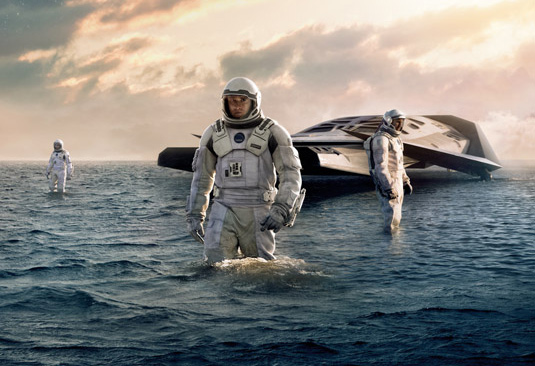
The work broke new ground, both artistically and scientifically: a paper on the research written by James, Thorne, CG supervisor Eugenie von Tunzelmann and VFX supervisor Paul Franklin was recently published in the American Journal of Physics – which promptly called for the movie to be shown in school science lessons to help explain general relativity.
In an interview with BBC News, Christopher Nolan commented that reactions like these were the "ultimate goal" of the movie. "We hoped that by dramatising science and making it... entertaining for kids we might inspire some of the astronauts of tomorrow," he said.
04. Inception
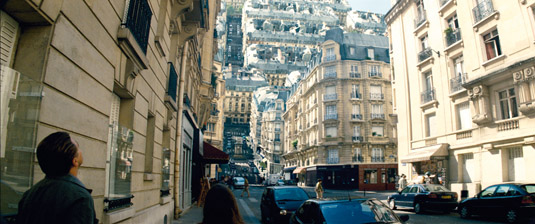
With Inception, director Christopher Nolan did the unthinkable: produced a blockbuster movie with an arthouse aesthetic. While the visuals are on a scale equal to his Batman movies, at its heart, the story is as tricksy as his celebrated low-budget debut Memento.
Rather than rely on multiple vendors to furnish the 500-odd digital effects shots (accounting for some 25 per cent of the movie’s running time), Nolan was keen to let Double Negative handle all the CG work, says VFX supervisor Paul Franklin. "Usually you'll have an independent VFX supervisor who divides the work across several studios, sometimes all over the world. Chris wanted to simplify the relationship. He described it more like a 1970s model, where the VFX department would operate within a film studio."
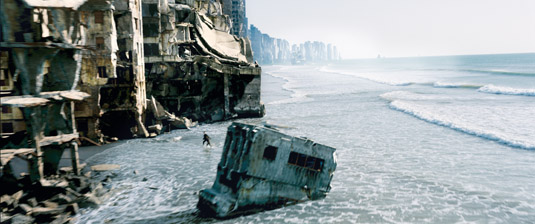
Whatever the reasoning, it worked. The team beautifully realised multiple-level dream worlds in which the laws of nature cease to apply. One scene in particular pushed audience's perceptions of what VFX could achieve. When architect Ariadne starts to "mess with the physics of it all" within her own dreamscape, she casually folds up Paris in front of Leonardo DiCaprio's unbelieving eyes.
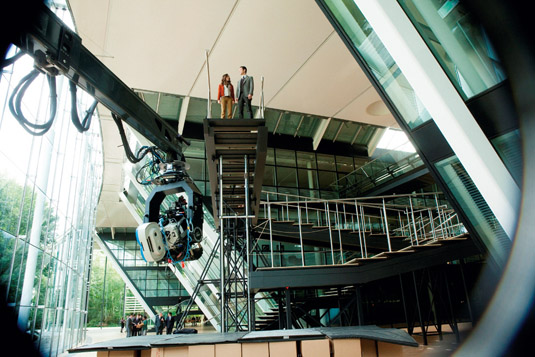
To achieve the intricate effect, the Double Negative team spent two weeks taking thousands of stills and working from millimetre-accurate LIDAR scans to replicate a photorealistic model of four Parisian apartment blocks, populating them with digital cars and people. The team had to devise a further series of cheats to fully achieve the shots needed, including hiding intersecting buildings behind other geometry and a set of careful camera moves.
The work won Double Negative its first Academy Award for Visual Effects. Four years later, the studio would win again – this time for Interstellar, featured above.
03. Terminator 2: Judgement Day
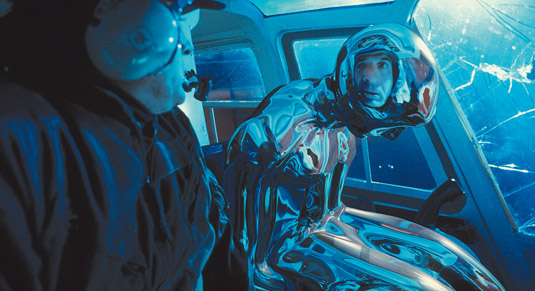
"I think Terminator 2 was more groundbreaking than Jurassic Park," says Dennis Muren, visual effects supervisor on – and VFX Oscar winner for – the classic sci-fi movie. "We had to put a lot of things in place for Terminator 2: complex rendering, compositing, and so on. But no one saw it until Jurassic Park."
After finishing work on the The Abyss in 1989, Muren took a year off. During that time, he read a 1,200-page book on CG. "I couldn’t figure out how it worked, but I wasn't afraid of it," he says. "I could tell Jim [director James Cameron], 'Yep, we can do this.'"
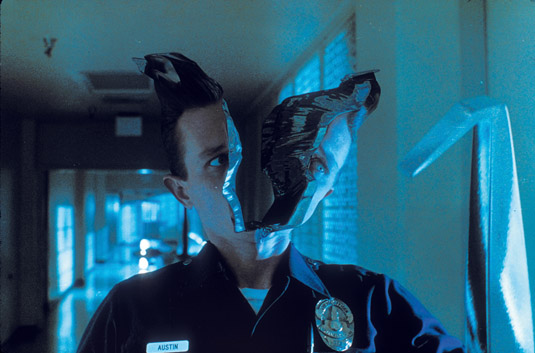
The 'this' in question was the T-1000, Terminator 2's iconic liquid metal cyborg. Compositing it with correct reflection maps to anchor it in the frame was difficult. "We had background plates and that environment needed to reflect in the character," says Muren. "The distortions had to remain consistent without creating big tears in the maps."
Another challenge was animation: when the T-1000 adopted actor Robert Patrick's form, animators moved it like a person. When it was liquid, animators moved the fluid. "We figured out as much as we could to keep the geometry from tearing," says Muren. "But we had an early copy of Photoshop, so if something didn't work [art director] Doug Chiang would go in and paint the frame."
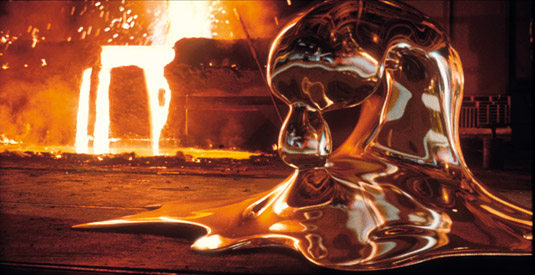
T2's biggest innovation, however, may have been that for the first time, the effects process was fully digital. "We had a film recorder that actually worked," Muren says. "We had a scanner that we had worked on with Kodak. So with the scanner, film recorder and our copy of Photoshop, we completed the triangle. It was the first time we could do digital in, digital manipulation and digital out."
02. Jurassic Park
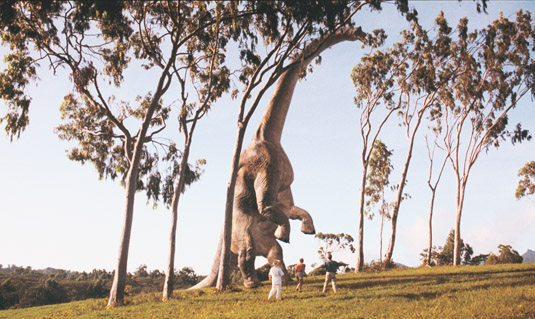
Why is Jurassic Park remembered so fondly for its visual effects? No-one knows the answer to that question better than Dennis Muren at Industrial Light & Magic, who won one of his eight visual effects Oscars for the film. "It was the first time we had been able to put living, breathing synthetic animals in a live-action movie," says Muren. "No-one had seen anything like it. The reality hadn't been done before; the naturalism."
Muren credits dinosaur supervisor Phil Tippett and, of course, director Steven Spielberg for pushing the unsafe documentary film style. "We wanted the animals to create the feeling that we wouldn't know what was going to happen next," Muren says.
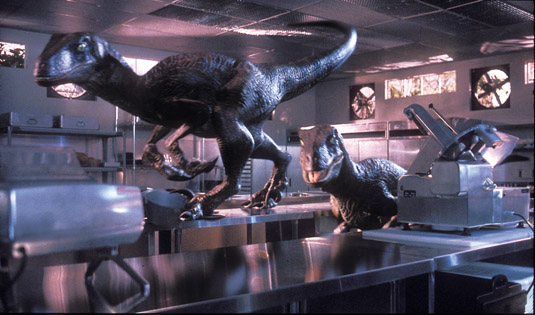
Because creating CG animals was so new, Muren set up two systems: stop motion and CG. "The animators hadn't worked on real animals," he says. "No-one had." Even though the CG animals soon proved themselves, Stan Winston's puppets starred in close-ups in most of the film. "When we started, I didn't think we could do anything closer than a full-length dinosaur in CG. But we pushed closer and closer. Near the end of the film, in the rotunda sequence when the T rex walks in and the raptor jumps on its back, I was confident enough to try close-ups."
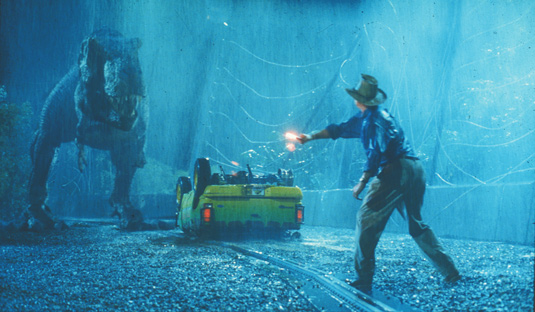
ILM's 56 CG shots and 6.5 minutes of screen time also included a digi-double for the lawyer (actor Martin Ferrero) as the T rex snags him out of a bathroom, and a face replacement for a character who falls through the floorboards during a raptor attack. Muren recalls: "George [Lucas] came by occasionally, and one time said, 'This looks pretty good.' I said: 'Yeah, I'm hoping we can do something like 2001, something brand new.' He said: 'You guys are doing it and you don't know it.' It wasn't until it was over that I realised he was probably right."
01. Avatar
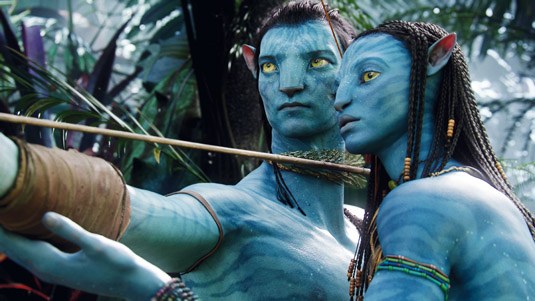
Back in 1996, James Cameron announced that he would be creating a science-fiction film called Avatar that would feature photorealistic computer-generated characters. Soon after, it had to be shelved as the technology of the time could not satisfy the creative desires of the director. But by 2009, things had caught up and Cameron, with help from a range of VFX studios, was about to make movie history.
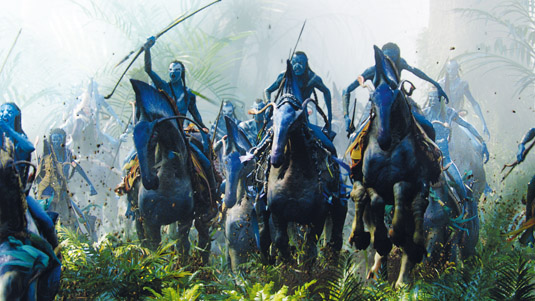
Avatar wasn't just a film, but a whole new, fantastical CG world – and the level of detail was astonishing. "James Cameron and his team spent a lot of time designing the horticulture of the environment," says Dan Lemmon, VFX supervisor at Weta Digital, which created over 1,800 effects shots for the movie. "There are very detailed and very exotic plants, many modelled by hand. Most of them were executed at fairly high detail. Larger trees had up to 1.2 million polygons."

As any given frame might have hundreds of thousands of plants to be rendered, efficiency was crucial. "We had to use proxy versions that would act as stand-ins in Maya and render procedurally in RenderMan," Lemmon says. "We put together level-of-detail strategies so that we could have more detail up close, and less geometry and detail as the camera gets further away."

The rendering time was further increased by the fact that Avatar was released in stereoscopic 3D: then still a relatively untested medium. On working with live-action stereo footage, Lemmon notes, "Before, we just worried about mattes, green spills, that sort of thing. Those issues become more complicated once you get into stereo.
"For example, things will look slightly shinier in one eye than the other." The mammoth effort that Weta put in to resolving these technical problems paid off: Avatar became the highest-grossing film of all time and changed the industry’s view of stereoscopic 3D overnight.
This article first appeared in 3D World magazine, the world's leading 3D and VFX magazine. Subscribe here.
Related articles:

Thank you for reading 5 articles this month* Join now for unlimited access
Enjoy your first month for just £1 / $1 / €1
*Read 5 free articles per month without a subscription

Join now for unlimited access
Try first month for just £1 / $1 / €1

The Creative Bloq team is made up of a group of design fans, and has changed and evolved since Creative Bloq began back in 2012. The current website team consists of eight full-time members of staff: Editor Georgia Coggan, Deputy Editor Rosie Hilder, Ecommerce Editor Beren Neale, Senior News Editor Daniel Piper, Editor, Digital Art and 3D Ian Dean, Tech Reviews Editor Erlingur Einarsson, Ecommerce Writer Beth Nicholls and Staff Writer Natalie Fear, as well as a roster of freelancers from around the world. The ImagineFX magazine team also pitch in, ensuring that content from leading digital art publication ImagineFX is represented on Creative Bloq.
